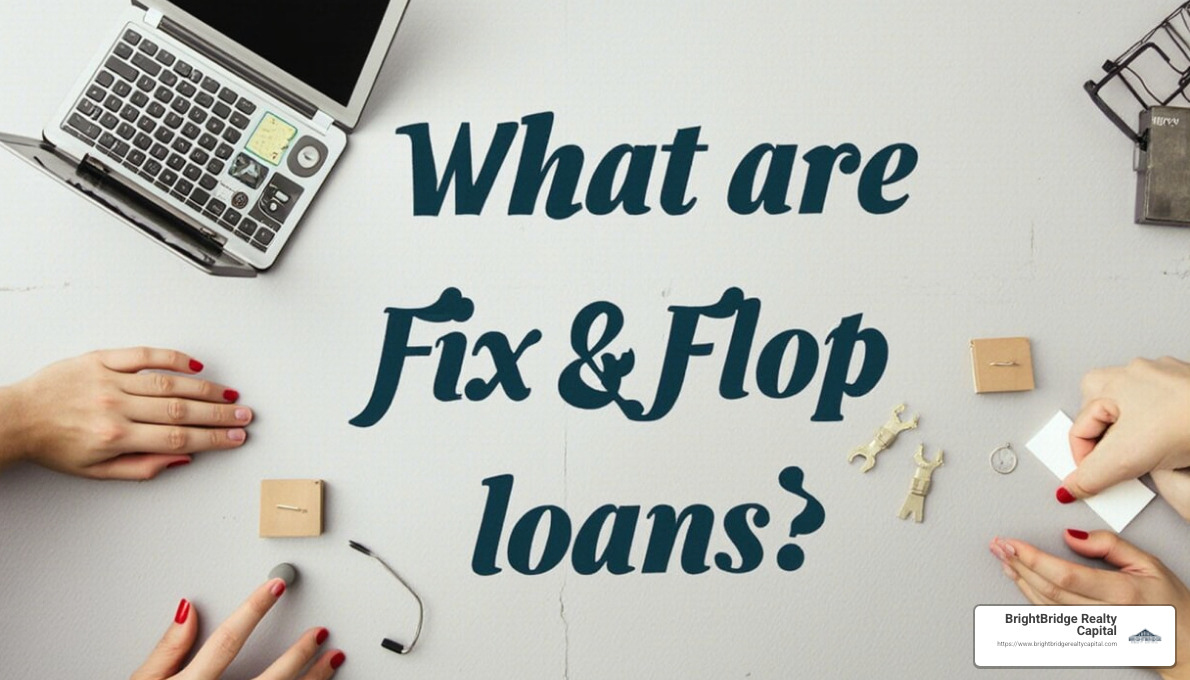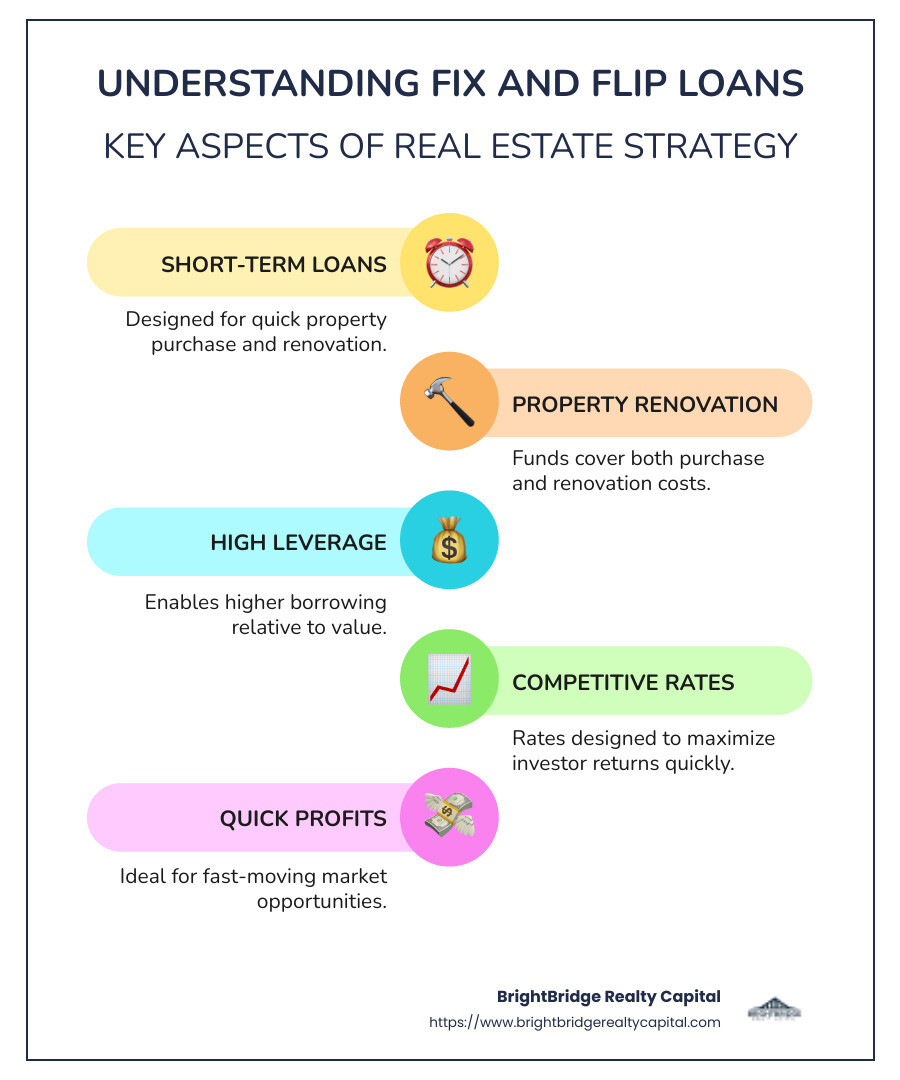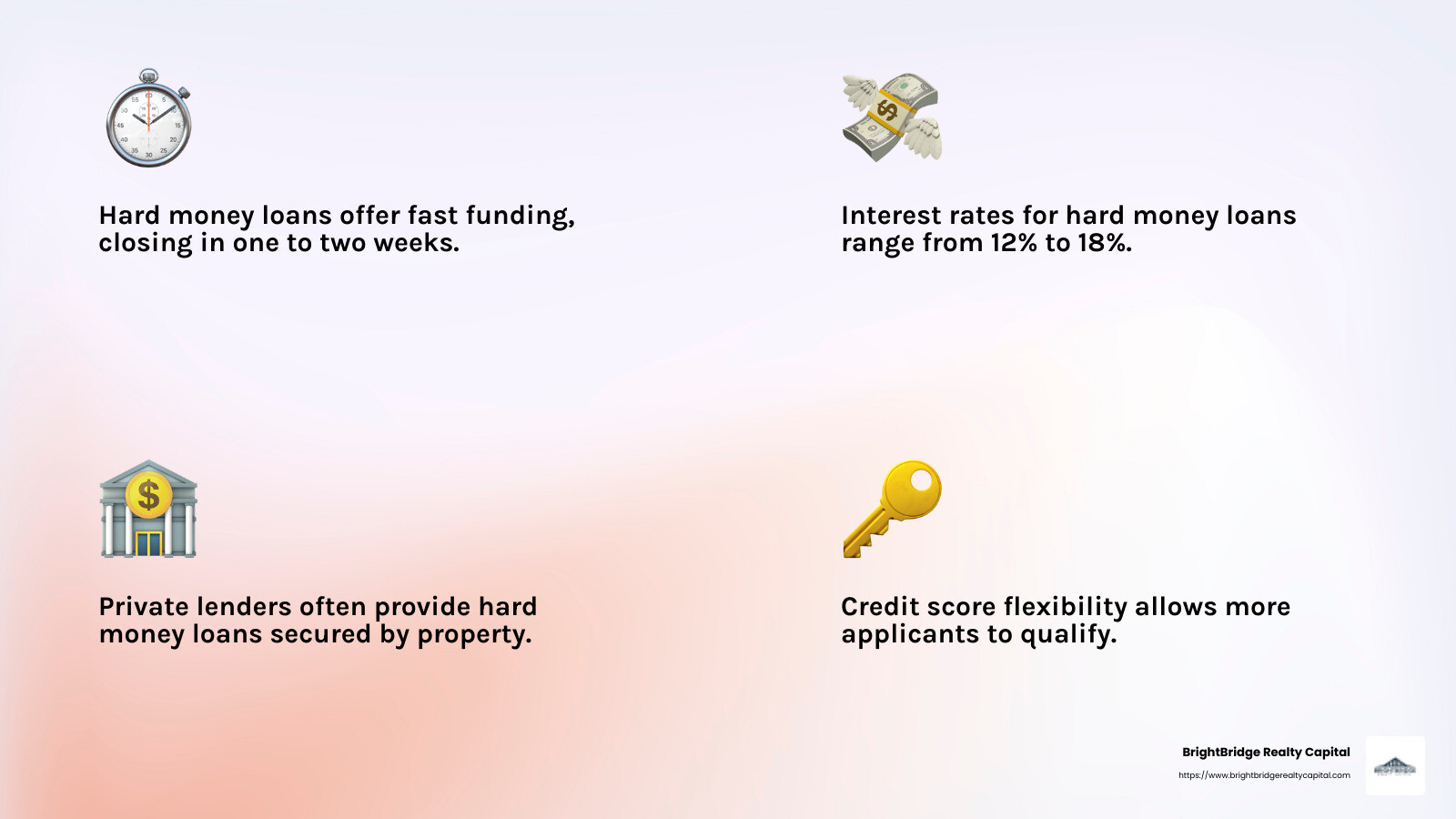The Ins and Outs of Fix and Flip Loans

What are fix and flip loans? Simply put, they are short-term loans designed for real estate investors who buy, repair, and sell properties for a profit. Whether you’re fixing cosmetic issues or doing major renovations, these loans can offer quick, flexible financing to get the job done efficiently. They cover both the purchase price and the renovation costs of the property, making them crucial for investors eager to capitalize on market opportunities without delay.
The fix and flip strategy has become a popular method in real estate investment. This method allows investors to buy undervalued properties, improve them, and sell at a higher price. The goal? Quick profits and high returns.
However, moving fast and having access to funds when needed are essential. That’s where fix and flip loans come into play. These loans are structured to provide funding quickly, often with high leverage and competitive rates, making them an ideal choice for investors looking to maximize their revenue without the long waits of traditional bank loans.

Must-know what are fix and flip loans terms:
What Are Fix and Flip Loans?
Key Features of Fix and Flip Loans
Fix and flip loans are a type of short-term financing designed to help real estate investors purchase, renovate, and resell properties quickly. These loans are custom for those who want to capitalize on the real estate market's potential by changing undervalued properties into profitable investments.
Key Features:
High Leverage: One of the standout features of fix and flip loans is the high leverage they offer. Investors can often borrow a significant portion of the property's purchase price and renovation costs. For example, BrightBridge Realty Capital provides up to 90% of the purchase price and covers 100% of the renovation budget. This high leverage allows investors to take on projects with less initial capital outlay.
Quick Closing: Speed is crucial in the competitive world of real estate. Quick closing is a significant advantage of fix and flip loans, with some lenders able to close deals in as little as one to two weeks. This rapid turnaround helps investors secure properties quickly, reducing the risk of losing out to cash buyers.
Competitive Rates: Despite being short-term, these loans often come with competitive interest rates. While they may be higher than traditional mortgages, the rates are balanced by the loan's short duration and the potential for high returns on investment.
Flexible Terms: Fix and flip loans offer flexible terms custom to the investor's project timeline. Options typically range from 12 to 24 months, allowing enough time to purchase, renovate, and sell the property. This flexibility is essential for aligning financial needs with project goals.
No Income Verification: For many investors, the lack of income verification is a huge plus. This feature simplifies the application process, making it easier and faster to obtain financing without the extensive documentation typically required for traditional loans.
These features make fix and flip loans a popular choice for real estate investors. By offering high leverage, quick closings, and competitive rates, these loans provide the financial tools needed to turn property renovations into profitable ventures.

In the next section, we'll explore the different types of fix and flip loans, including hard money loans, private money loans, and bank loans, to help you determine which option might be the best fit for your investment strategy.
Types of Fix and Flip Loans
When it comes to financing your real estate renovation project, there are several types of fix and flip loans to consider. Each type has its own advantages and challenges, so it's important to choose the one that aligns best with your investment strategy.
Hard Money Loans
Hard money loans are a top choice for many real estate investors due to their fast funding capabilities. These loans are typically offered by private lenders and are secured by the property itself. This means that even if your credit isn't perfect, you might still qualify.
- Fast Funding: Hard money loans can close in as little as one to two weeks, which is crucial when you're competing for properties.
- High Interest Rates: While the speed is a major perk, these loans come with higher interest rates, often ranging from 12% to 18%. The trade-off is the quick access to cash and the ability to grab opportunities as they arise.

Private Money Loans
Private money loans come from individuals or private groups willing to invest in your project. These loans offer flexible terms and are known for their quick approval process.
- Flexible Terms: Unlike traditional lenders, private lenders might offer more lenient terms custom to your specific project needs. This can include flexible repayment plans or extensions if needed.
- Quick Approval: These loans often have a faster approval process compared to bank loans, allowing investors to act swiftly on promising deals.
Bank Loans
For those looking for lower interest rates, bank loans might be an appealing option. However, these loans come with more stringent requirements.
- Lower Interest Rates: Bank loans generally offer lower rates compared to hard money loans, making them more cost-effective over time.
- Stringent Requirements: The downside is the rigorous qualification process. Banks typically require a strong credit score, detailed financial documentation, and sometimes a substantial down payment. This can slow down the process, which may not be ideal in a fast-moving market.
Each type of loan has its place in real estate investing. Whether you prioritize speed, flexibility, or cost, understanding these options can help you make the best decision for your next fix and flip project.
In the following section, we'll dig into how these loans work, focusing on purchase and rehab processes, loan-to-value ratios, and after-repair value considerations.
How Fix and Flip Loans Work
Loan-to-Cost and Loan-to-Value
When diving into a fix and flip loan, understanding the loan-to-cost (LTC) and loan-to-value (LTV) ratios is crucial. These ratios dictate how much financing you can secure for your project.
Loan-to-Cost (LTC): This ratio compares the loan amount to the total cost of the project, including the purchase price and renovation expenses. For example, if your total project cost is $200,000 and a lender offers 85% LTC, they might fund up to $170,000. You'll need to cover the remaining $30,000.
Loan-to-Value (LTV): This ratio assesses the loan amount against the property's value. Typically, fix and flip loans offer up to 70% LTV based on the after-repair value (ARV) of the property. If your property's ARV is $300,000, the maximum loan could be $210,000.
Both LTC and LTV are vital in determining your down payment requirements. Higher ratios mean less initial cash outlay, but they also come with higher risk and interest rates.
Renovation and Resale Process
The heart of the fix and flip strategy lies in the renovation and resale process. This is where the magic happens, turning a rundown property into a market-ready gem.
Purchase and Rehab: Once you've secured financing, the next step is purchasing the property and beginning renovations. This could range from minor cosmetic updates to major structural overhauls. Hiring a reliable contractor is essential to keep the project on track and within budget.
Property Upgrades: Strategic upgrades can significantly boost a property's market value. Focus on areas that offer the highest return on investment, such as kitchens and bathrooms. However, be cautious not to over-improve, as this can eat into your profits.
Market Value Increase: The goal is to increase the property's value above the combined cost of purchase and renovation. This is where your profit margin comes into play. By carefully managing costs and understanding market trends, you can maximize your return.
Once renovations are complete, the property is ready for resale. The aim is to sell quickly to minimize holding costs like loan interest, taxes, and utilities. With a well-executed plan, the property should attract buyers willing to pay top dollar, ensuring a successful flip.
In the next section, we'll explore the benefits and risks associated with fix and flip loans, helping you weigh the potential rewards against the inherent challenges.
Benefits and Risks of Fix and Flip Loans
Advantages
High Returns: One of the biggest draws of fix and flip loans is the potential for high returns. By purchasing a property at a low price, renovating it, and selling it at a higher market value, investors can quickly realize significant profits. Shows like "Fixer Upper" have popularized this strategy, highlighting the lucrative nature of house flipping.
Quick Profits: Unlike traditional real estate investments that might take years to mature, fix and flip projects usually complete within months. This rapid turnaround allows investors to reinvest their profits into new projects, potentially compounding their earnings over time.
Flexible Financing: Fix and flip loans offer flexible financing options custom to the unique needs of each project. Whether you're looking for a hard money loan with fast funding or a private money loan with flexible terms, there's a solution to fit your strategy. This flexibility can be crucial for navigating the unpredictable nature of real estate investment.
Disadvantages
High Interest Rates: While fix and flip loans provide quick access to capital, they often come with high interest rates. These rates can significantly impact your profit margin if the project takes longer than expected or if the resale price falls short of projections.
Financial Pitfalls: The costs associated with flipping houses can add up quickly. From unexpected renovation expenses to holding costs like taxes and utilities, financial pitfalls are a real risk. Accurate budgeting and contingency planning are essential to avoid eroding your profits.
Market Volatility: The real estate market can be unpredictable. Changes in market conditions, such as a sudden drop in property values, can impact your ability to sell at a profit. This volatility underscores the importance of understanding local market trends and timing your investments wisely.
Potential Losses: Despite the potential for high rewards, fix and flip projects carry the risk of significant losses. If renovation costs spiral out of control or if the property doesn't sell quickly, you could end up with a financial burden rather than a profit. It's crucial to conduct thorough due diligence and have a clear exit strategy in place.
In the next section, we'll address some frequently asked questions about fix and flip loans, providing further insight into this dynamic investment strategy.
Frequently Asked Questions about Fix and Flip Loans
What are the typical terms for fix and flip loans?
Fix and flip loans are short-term, usually lasting between 6 to 18 months. They're designed to help investors quickly purchase, renovate, and resell properties. Interest rates are higher than traditional loans, often ranging from 8% to 12%. These loans can cover up to 90% of the purchase price and 100% of the renovation costs, depending on the lender. There's often no prepayment penalty, allowing investors to pay off the loan early if they sell the property quickly.
How do I qualify for a fix and flip loan?
Qualifying for a fix and flip loan depends on several factors:
Credit Score: While a good credit score helps, many lenders focus more on the property's potential rather than personal credit. However, a score of at least 620 is often required.
Experience: Lenders prefer borrowers with a track record of successful flips. If you're new, partnering with an experienced investor can improve your chances.
Down Payment: Expect to provide a down payment, usually 10% to 20% of the total project cost.
Property Appraisal: The property's potential value after renovation (ARV) is crucial. Lenders will assess this to determine loan amounts.
What are the costs associated with fix and flip loans?
Several costs are associated with fix and flip loans:
Interest Rates: High interest rates, typically 8% to 12%, can increase the total cost of borrowing.
Origination Fees: These are upfront fees charged by the lender, usually 1% to 5% of the loan amount.
Closing Costs: Include title insurance, appraisal fees, and other administrative expenses.
Renovation Costs: Cover the expenses for property improvements. Accurate budgeting is essential to avoid overspending.
Holding Costs: While the property is being renovated and sold, you'll incur holding costs like taxes, insurance, and utilities.
Understanding these costs can help you plan your project budget effectively, ensuring that you maximize your investment returns.
Next, we'll explore the conclusion, highlighting how BrightBridge Realty Capital can provide the customized financing solutions you need for a seamless fix and flip experience.
Conclusion
At BrightBridge Realty Capital, we understand the unique challenges and opportunities that come with fix and flip investments. Our mission is to provide customized financing solutions that help you steer these challenges with ease.
Why Choose BrightBridge Realty Capital?
Quick and Flexible Funding: We specialize in fast closings, often within a week. This speed is crucial in the competitive real estate market, allowing you to secure properties quickly and start renovations without delay.
Direct Lending: As direct lenders, we eliminate intermediaries, offering a seamless process and competitive rates. This means less hassle for you and more focus on your project.
Custom Solutions: We offer a range of loan options to fit your specific needs, whether you're a seasoned investor or a first-time flipper. Our team works with you to customize the loan terms, ensuring you have the best possible financial support for your project.
Expert Guidance: With our experience in the real estate industry, we're here to guide you through every step of the process. From evaluating potential properties to understanding loan terms, our experts are ready to assist you.
By choosing BrightBridge Realty Capital, you're partnering with a team committed to helping you turn your fix and flip vision into reality. Explore our services and see how we can help you achieve your real estate investment goals.


